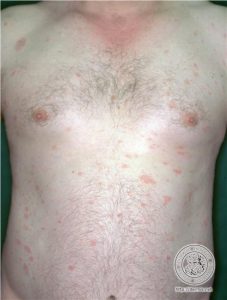SERVICES
- Allergy Screening
- Chemical Peels
- Dermapen
- Facial Skin Analysis
- FreshEyes
- Hyperhidrosis (Excessive Sweating)
- Hair Loss Treatment
- Laser Clinic
- Liquid Facelift
- Keloid Treatments
- Medical Facials
- Medical Treatments
- Mole Mapping
- Photodynamic Therapy (PDT)
- Skincare Advice
- Pigmentation Treatment
- Surgical Procedures
- Ultraviolet Phototherapy
USEFUL LINKS
What is pityriasis rosea?
 Pityriasis rosea is a common and harmless rash that goes away by itself after about 8 weeks. Its name means that the rash is scaly (pityriasis) and pink (rosea).
Pityriasis rosea is a common and harmless rash that goes away by itself after about 8 weeks. Its name means that the rash is scaly (pityriasis) and pink (rosea).
What causes it?
The cause of pityriasis rosea is still not known. It may be due a reaction to a harmless virus as it occurs in clusters and is most common in the winter. The risk of passing it on to anyone else seems to be very low. It is most common between the ages of 10 and 35 years.
Is pityriasis rosea hereditary?
No.
What are its symptoms?
You may have a mild headache, and feel unwell just before the rash comes up, or even when the rash is present. The rash can be itchy.
What does pityriasis rosea look like?
The first sign of pityriasis rosea is a single patch, which is known as a ‘herald patch’ because it comes up a few days, or even a couple of weeks, before the rest of the rash. A ‘herald patch’ is:
- Usually single.
- Usually on the trunk.
- Larger (2 – 5 centimetres across) than the other patches that come up later.
- Round or oval and, at first, bright red, and scaly. Later it becomes paler with a ring of scaling (known as a collarette) just inside its edge.
Later on — a few days after the herald patch came up – a different type of rash appears:
- It is made up of many small oval patches (1 — 2 centimetres across).
- They are pink and, like the herald patch, they may also have a ring of scaling just inside their edge.
- Most of these patches will be on the trunk, but some may come up on the limbs and neck too.
- On the trunk, these patches take up what is known as a ‘Christmas tree pattern’. This means that the oval pink areas line up in such a way that they run downwards and outwards from the centre, in much the same way that the branches of a Christmas tree run downwards and outwards from the trunk.
- They come up in crops, at intervals of a few days, for a week or two and then fade slowly over the next 6 — 8 weeks, usually leaving no trace. They may leave light or dark patches in people with a dark skin, but these marks do eventually fade. Second attacks are rare.
How will it be diagnosed?
There are no diagnostic tests for pityriasis rosea, but the story of a herald patch and the appearance of the rash will usually be enough for your doctor to make the diagnosis. If there is any doubt, or the rash lasts longer than two months, your doctor may want to send a sample of your blood to the laboratory to rule out other rashes that can look rather like pityriasis rosea. The herald patch can sometimes be mistaken for an area of ringworm, and your doctor may wish to check this by sending a skin scraping to the laboratory.
Can it be cured?
Pityriasis rosea goes away by itself and treatment does little to speed this up.
How can it be treated?
Usually no treatment is needed. A mild corticosteroid such as hydrocortisone cream or calamine lotion may help if the rash is itchy and extensive. If the itching is still severe despite these treatments, your doctor may suggest a stronger steroid cream or treatment with ultraviolet light.
What can I do?
- Remember that the story given above is right in most cases; but there may be variations on the theme. Occasionally a herald patch does not turn up, or two or three herald patches may crop up at the same time. Sometimes the widespread rash can last for as long as 3 months. If it is still not clearing at that stage, consult your doctor again.
- There is no reason to keep children with pityriasis rosea away from school.
- There is no need for treatment if the rash does not bother you
Patient Testimonials
EXCELLENTTrustindex verifies that the original source of the review is Google. From my first visit with Dr Jhetam I knew I would go back. He is compassionate , friendly and has an interaction which made you feel comfortable. This is very important in any doctor because our relationship with our doctor is very intimate.Trustindex verifies that the original source of the review is Google. Dr Jhetman is truly one of a kind. Anyone who is fortunate enough to be in his care can so grateful. Academic, informative and reassuring. It’s hard to find a doctor who has this combination of skills these days. He dealt with my Melonoma concerns with swift and professional care. And his staff are equally as competent and caring. I cannot commend Dr Jhetman and his staff enough on true patient care. Thank you!Trustindex verifies that the original source of the review is Google. I was absolutely satisfied with my experience with Dr Jhetham & his winning team. Keep up the good work.Trustindex verifies that the original source of the review is Google. Best skin doctor..Dr Jetham prescribed the best products that have brought so much of a glow to my skin..being a transplant patient and so much happening to my skin just 4 visits to him and my face is back to it's radiance ..I hightly reccomend Dr Jetham ...you won't go wrong..Trustindex verifies that the original source of the review is Google. Dr. Imraan Jhetam and his team provided exceptional care, showcasing professionalism and compassion in every interaction. Dr. Jhetam took the time to thoroughly explain everything, addressing each of my concerns with empathy and understanding. My experience with him was truly wonderful, and I highly appreciate his dedication to patient care.Verified by TrustindexTrustindex verified badge is the Universal Symbol of Trust. Only the greatest companies can get the verified badge who has a review score above 4.5, based on customer reviews over the past 12 months. Read more



